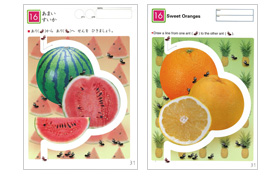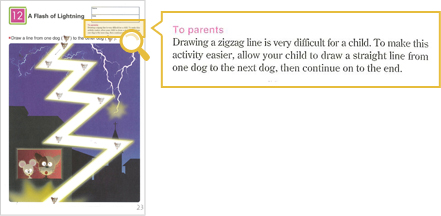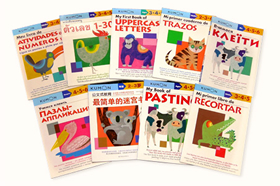History of Foreign Language Versions of Kumon Workbooks
 |
| Left: Japanese version Right: English version |
In 1977 Kumon Publishing first began publishing the Kumon workbook series in Japan. These workbooks, which are available in book stores and over the internet, are intended for children who aren’t able to attend a Kumon center and for students who are not yet enrolled. Kumon Publishing started its line of translated Kumon workbooks in 2004.
The aim was to provide workbooks to children around the world focusing on basic study skills that develop academic ability. The first volumes published (eight types) were English version workbooks for early learners. Initially we began working with Barnes & Noble, a large American book distributor, to sell our books. Almost immediately after that, we received inquiries from publishers in 24 other countries who expressed an interest in working with us. Thanks to this excellent response we started overseas marketing on a full-scale.
Today we have widened our target group to the range from early learners to junior high school second graders. In addition we have increased the number of types of workbooks that we offer. Across all series we now publish 170 types of workbooks.
Beginning with the English version, we have moved on to publish versions in nine languages including Spanish, Russian, Thai and Chinese. At present our workbooks are being sold in 57 countries and regions in North America, South America, Asia, Africa, Europe and Oceania. It is necessary of course to make changes in the workbooks in order to adapt to the culture and customs of each country. For example, in Japan there is a page showing a round watermelon which the child uses for practice writing circles. However, in the United States of America watermelons are oval in shape. Therefore, oranges and grape fruits were used in the version translated into English.
Why are Kumon workbooks popular?
Why are Kumon workbooks popular in countries having different educational systems from Japan?
 Countries and regions where Kumon workbooks are available |
The strong points of Kumon workbooks make them popular even in countries with different educational systems and curriculums from Japan. Kumon workbooks are not designed to follow the educational systems and curriculums of any country. Rather, the topics of study are carefully chosen to promote the development of critical skills children need in life. Kumon workbooks cover six areas. This includes the basic level that deals with letter and language skills, number skills, paper cutting, paper folding, and paper pasting.
There are also workbooks covering Math and Reading for early learners, elementary school students, and junior high school students. With a lineup ranging from the basic level all the way up through high-level material, every student can choose the workbook that is just right for him or her. Just like the Kumon Method study program, the contents of our workbooks are carefully chosen. Therefore, they are increasingly popular all around the world.
Another reason for their popularity is because they are made based on the “small-step” concept, which is a fundamental characteristic of the Kumon Method. Kumon workbooks are not packed with large amounts of unrelated material. Rather, they take up one limited theme such as the alphabet or addition, for example. The workbooks are structured so that students solve the problems in a step-by-step manner leading to smooth progress. Therefore, students gain an awareness of skill improvement and a feeling of accomplishment. The Kumon workbooks truly help students experience the joy of learning.
A final point that can be mentioned is that the workbooks are designed from the point of view of children and are full of enjoyable material. During development we observed monitor children and, then, incorporated what we learned in the workbooks. For example, in the development stage we observed that children sometimes stop writing when they are doing exercises of linking dots. Therefore, we put in light guide lines to be traced and arrows showing the direction of writing. The goal is to balance the difficulty of the task with the amount of writing that we want the student to carry out.
In addition, our workbooks include hints and advice for parents (“To parents”) regarding points to keep in mind when overseeing their child’s study. The idea is to encourage communication between parents and children leading to enjoyable study and good progress.
 Advice for parents “To parents” |
The incorporation of all of these elements in the workbooks is aimed at promoting pleasant study regardless of nation or region. The person-in-charge at Kumon Publishing said, “We will continue to strive to produce learning materials that are enjoyable to study and allow students to make smooth step-by-step progress leading to a sense of accomplishment and confidence in the learner.”

